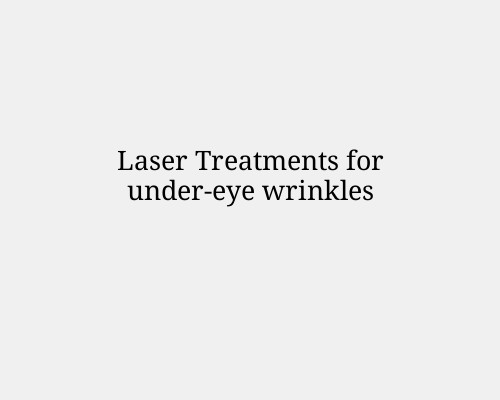
Laser Treatments for under-eye wrinkles: What to expect and are they worth it?
Under-eye wrinkles are among the earliest signs of aging, thanks to the skin in that area being especially thin and delicate. Environmental stressors, genetics, repetitive facial expressions, and the natural decline of collagen contribute to creases, fine lines, and sagging. While skincare products can help to an extent, laser treatments offer a more intensive and targeted approach to rejuvenation. Among the most common types used for under-eye wrinkles are fractional CO2 lasers, erbium lasers, and non-ablative lasers. Here’s what you need to know about each— how they work, what to expect during and after treatment, and whether the investment is worthwhile.
How Laser Treatments Work on Wrinkles
Laser resurfacing works by creating controlled damage to the skin’s surface or deeper layers. This injury triggers the body’s natural healing response, stimulating collagen and elastin production. The end result is smoother, firmer skin with fewer wrinkles and more even tone and texture.
Laser treatments fall into two main categories:
Ablative lasers: These remove the outer layer of skin (epidermis) and heat the underlying skin (dermis) to stimulate collagen. They offer dramatic results but come with more downtime and higher risks.
Non-ablative lasers: These work beneath the skin’s surface without removing the top layer, resulting in less downtime but more gradual results.
Each laser option differs in aggressiveness, recovery time, and effectiveness.
Fractional CO2 Lasers How It Works:
Fractional CO2 (carbon dioxide) lasers use intense beams of light to create microscopic holes in
the skin. These micro-injuries encourage collagen remodelling while leaving surrounding skin intact, which helps speed up healing. The fractional component means the laser targets only a portion of the skin at a time rather than the entire area.
Best For:
Deep under-eye wrinkles
Severe sun damage
Crepey or sagging skin
Moderate to advanced signs of aging
Pros:
Delivers some of the most dramatic results for deep wrinkles
Tightens and thickens thin under-eye skin
Improves pigmentation and texture in a single treatment
Cons:
Significant downtime (7–14 days)
High risk of swelling, redness, crusting, and post-inflammatory hyperpigmentation
Not suitable for darker skin tones due to risk of pigmentation issues
Painful procedure (usually requires numbing cream and sometimes sedation)
Cost:
$1,000–$3,000 per session
Multiple sessions may be recommended, but many patients see results after just one.
Recovery:
Swelling, redness, and peeling are expected for up to two weeks. Makeup is usually not permitted for 7–10 days post-procedure. Sun protection is critical for several months after treatment.
Erbium Lasers
How It Works:
Erbium:YAG lasers are ablative like CO2 lasers but operate at a wavelength that is more readily absorbed by water in the skin, allowing for more precise ablation with less thermal damage. This makes them less aggressive but still effective for treating fine to moderate wrinkles.
Best For:
Mild to moderate under-eye wrinkles
Patients with sensitive skin
Those seeking shorter recovery
Pros:
Less downtime than CO2 lasers (3–7 days)
Lower risk of scarring and pigmentation problems
Can be safer for patients with medium skin tones (Fitzpatrick III–IV)
Cons:
Less effective on deep wrinkles
May require multiple sessions
Still carries risk of redness and peeling
Cost:
$600–$2,000 per session
Recovery:
Peeling, mild swelling, and redness may occur. Makeup can typically be worn after 4–5 days. Healing is faster than CO2 but still requires gentle care and strict sun avoidance.
Non-Ablative Lasers (e.g., Fraxel, Clear + Brilliant) How It Works:
Non-ablative lasers, like the Fraxel Restore and Clear + Brilliant, target the deeper layers of
skin (dermis) without damaging the surface. These lasers stimulate collagen growth gradually over time. Because they don’t break the skin barrier, they involve minimal recovery.
Best For:
Fine lines and early signs of aging
Younger patients (30s–40s)
Maintenance after more aggressive treatments
Pros:
Minimal downtime (1–3 days of mild redness or puffiness)
Safer for all skin tones
Comfortable procedure (usually just requires topical numbing)
Cons:
Subtle results compared to ablative lasers
Requires a series of treatments (3–6 sessions spaced weeks apart)
Not effective for deep wrinkles
Cost:
$300–$800 per session, with a recommended 3–6 sessions for full results
Recovery:
Redness and mild swelling typically resolve within a few days. Makeup can be applied within 24–48 hours. Strict sun protection is still necessary, though the risk of pigmentation is lower.
Are Laser Treatments Worth It for Under-Eye Wrinkles?
Yes—but with caveats. Laser resurfacing is one of the most effective methods for reducing under-eye wrinkles, but expectations must be realistic. The degree of improvement depends on the type of laser, your skin condition, age, and how well you follow post-treatment care.
If you’re seeking maximum results and are willing to accept more downtime and risk,
fractional CO2 or erbium lasers can deliver dramatic improvements.
If you want gradual, safer improvements with less disruption to your daily life, non- ablative lasers are a solid option—but they require patience and multiple sessions.
Also, laser treatments don’t stop aging. Maintenance is often necessary every 1–2 years, especially with non-ablative options. You’ll also need a diligent skincare routine and regular sun protection to maintain your results.
Who Should Avoid Laser Under-Eye Treatments?
People with active skin infections or eczema in the area
Those with very dark skin tones (unless cleared by a qualified dermatologist)
Individuals prone to keloid scars or pigmentation disorders
Pregnant or breastfeeding women
Those taking photosensitizing medications (e.g., Accutane)
Final Thoughts
Laser treatments can significantly improve under-eye wrinkles, but they’re not a miracle solution. The right choice depends on how aggressive you’re willing to go, your skin type, and your budget. Always consult with a board-certified dermatologist or plastic surgeon who specializes in laser resurfacing for the delicate under-eye area. Done properly, laser treatments can turn back the clock—just don’t expect it to stop time altogether.